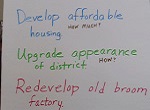Local Community Action Agencies Offer Poverty Aid
Last Updated: June 20, 2024
Your local community action agencies should be the focal points for fighting poverty as experienced on an individual basis in the U.S. About 1,000 of these private corporations exist, and they cover 96% of counties in the U.S. Recently their funding has been under attack, perhaps because their results vary widely by location. Fiscal health of these organizations varies widely, depending on the particular mix of programs and funding strategies each one employs.

Core funding for these organizations, sometimes known as CAAs, is provided by the Community Services Block Grant under the U.S. Department of Health and Human Services, not Housing and Urban Development (HUD). These agencies were established through the 1964 Economic Opportunity Act as part of the War on Poverty.
Their boards of directors must consist of at least one-third low-income individuals from the geographic area served, exactly a third public officials, and the remainder as private citizens.
Community anti-poverty programs available differ considerably from place to place. About the only common activities are community information and referral, community engagement, and focus on at least alleviating the symptoms and realities of poverty, if not its causes. They often jump in to meet immediate needs. For example, I helped someone find their community action agency's healthcare navigator when the Affordable Care Act was first implemented.
Having said that, because federal and other funding opportunities tend to shape the missions of private corporations that rely on these sources, there are some typical activities that you could check for in your location.
About half of the CAAs cover rural areas, and therefore their geographic area can be vast. So here's the link to how to find a community action agency, but don't count on it being a 20-minute drive if you live in rural America. It might be more like an hour and a half, which is fine if you are a professional and a committee member, but not so fine if you are a person in desperate need of services. Let's see what these agencies typically have to offer.
Common Activities of Community Action Agencies
While individual self-sufficiency is the stated goal of CAAs, sometimes their attitudes resemble those of other state or federal benefit programs. When I walked into my community action agency office for a meeting, was greeted and immediately ushered through a maze of offices to the meeting room, it did not feel good that I could overhear moms with crying babies being told to come back tomorrow because it was getting close to 5:00 p.m. So staff attitudes vary, just as the programs do.
Returning to the programs themselves, Head Start, a school readiness program, is one of the most typical activities, although in some areas, other social service organizations have been more effective in rescuing failed Head Start programs.
Weatherization and utility bill assistance also are common threads. Many have received green jobs or other environmental sustainability initiatives money recently.
Often community action agencies provide job training programs and may offer preparation for the GED exam (now called TASC (Test Assessing Secondary Completion). In rural areas especially, transportation programs are somewhat prevalent. Typically these would be "on demand" programs, where an individual needing transportation to doctor's appointments, the grocery store, or other essential business calls to make an appointment for a particular pick-up location and destination.
Sometimes CAAs become active in health care, operating clinics but more frequently administering WIC programs. WIC is an acronym for Women, Infants and Children, and it is a federal program entitling low-income recipients who are pregnant or have small children to certain free grocery items such as milk and juice. Many community action agencies offer navigation services for people signing up for the Affordable Care Act or maybe a state Medicaid program.
Another possibility is that the CAA will offer rent assistance on an emergency basis. Urban community action agencies are not much involved in housing, where other specialized organizations exist, but this is a potential program especially in a rural area.
Relatively recently the agencies have adopted what they call the promise, with the goal of making sure that people leave feeling better about their situation. This softer feel-good and customer-oriented approach often differs from completely government-run programs, where a certain bureaucratic disdain for the comfort of the aid recipients too often is evident.
Questioning the Effectiveness of Community Action Agencies
It is the right of every citizen concerned about community poverty to question whether their local community action agency is effective or not. To be truthful, effectiveness varies hugely from one group to another across the land. Most are run by dedicated, hard-working do-gooders, and we mean that term in the very best complimentary sense. But of course, there have been a few instances of administrators taking advantage of the situation to be overpaid or simply inattentive.
Since the corporation is considered private, you sometimes have to argue if you want a clear view into community action agencies. However, in the end, you may want to try to position yourself or someone you know to serve on the board of directors, and you certainly have the right to ask the public officials who serve on the board to account for their actions there and for the conduct and especially the effectiveness of the CAA’s activities.
You may have to become a community activist yourself if you find your local CAA lacking. Organizational culture certainly can be changed, but either new leadership or sustained work with the existing leadership will be required if you and others you know find your local organization lacking.
Next we'll give you a list of questions to ask yourselves as you evaluate your local corporation.
Checklist for Evaluating Community Action Agencies
• Does the organization choose the most appropriate set of programs to alleviate the human suffering that accompanies poverty?
• Is the board transparent enough that the community understands its goals, its processes, and its mission?
• Is the service attitude embodied in every employee and in every transaction with a potential aid recipient (who should be thought of as a customer)?
• Does the organization simply chase federal funding for community action agencies, changing its business model often to position itself for funding, or it is thoughtful in its approach to local needs and local assets?
• Speaking of assets, has the organization embraced asset-based community development, or is it still stuck in a mentality that only sees needs that its resources are inadequate to meet?
• Is your CAA entrepreneurial in spirit? We don’t mean does it run a business, but we mean is it aggressive and imaginative about pursuing ideas and creative partnerships that might help relieve the root causes of poverty in your community?
• Is the CAA administration active in the entire community, so as to build support and understanding for its goals and mission?
• Are the employees provided with current information and challenged continuously with new ideas about better service, information and referral resources for customers, and broad community issues and economic realities?
• Are the finances of the organization in line with what is typical for community action agencies, and are they squeaky clean? Are executive compensation levels and perks kept reasonable in view of the fact that the customers are people in poverty?
• Does your CAA actively seek and build new partnerships to deal with relevant community problems that are outside the scope historically considered by community action agencies? On this point, we believe that the survival of the CAA model depends in part on whether these agencies can broaden their scope to include convening of partnerships that benefit additional populations. As examples, we urge consideration of the special needs of immigrants if there are no other groups dedicated to this work. A second very promising role for a CAA could be the convening and staffing of community anti-drug coalitions.
Read More About Poverty Topics
- Making and Keeping a Good Community >
- Community Organizations > Community Action Agencies
Join GOOD COMMUNITY PLUS, which provides you monthly with short features or tips about timely topics for neighborhoods, towns and cities, community organizations, and rural or small town environments. Unsubscribe any time. Give it a try.




